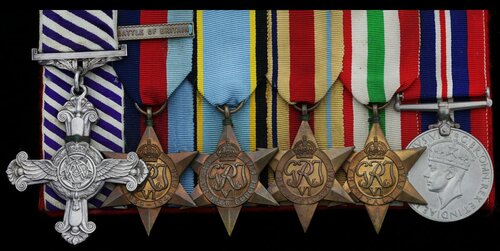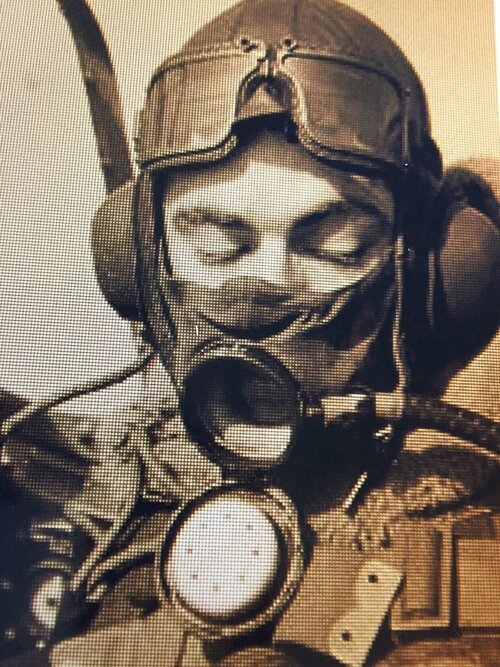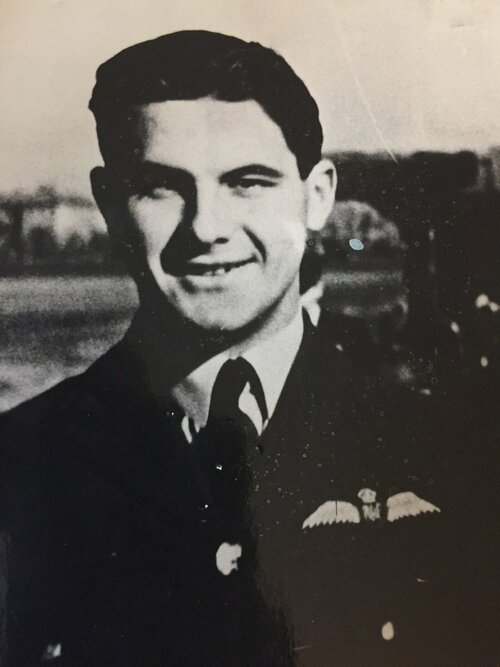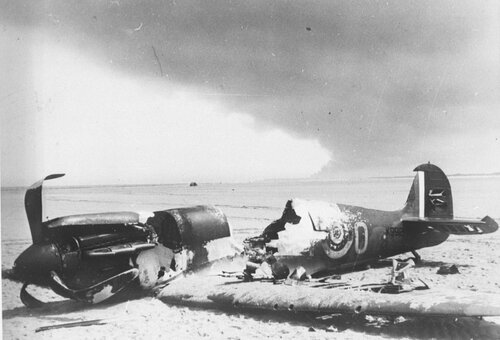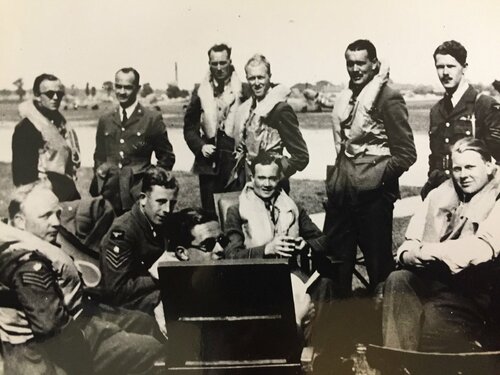Auction: 21001 - Orders, Decorations and Medals (conducted behind closed doors)
Lot: 414
'I met Kenny Hart in 65 East India Squadron when I joined it in August 1940 at R.A.F. Hornchurch. He was a very lively fellow, and full of good humour and friendly. I liked him as a friend and a fellow pilot. He seemed always to have a smile on his face.'
Squadron Leader Boleslaw Drobinski, D.F.C., one of the Poles who flew in 65 Squadron in the Battle of Britain, recalls a gallant comrade.
The notable - and poignant - Second World War fighter ace's D.F.C. group of six awarded to Squadron Leader K. G. 'Kenny' Hart, Royal Air Force, a distinguished veteran of the Battle of Britain who was killed in action in December 1944
He opened his account as a 19-year-old Spitfire pilot in No. 65 Squadron on 26 May 1940, downing a Me. 109 over France before himself being compelled to undertake a forced-landing on the beaches of Dunkirk. In a storyline and scene reminiscent of Christopher Nolan's recent and acclaimed film of that name, he 'torched' his shot-up aircraft and managed to get home
Another 109 having fallen to his guns in late June, he remained much engaged throughout the Battle of Britain, claiming yet another 109 and a probable He. 111 in August; his Spitfire was once again hit by return fire on the 20th, leading to his second forced-landing, on this occasion on Havengore Island, Foulness
Next seeing action in Tomahawks of No. 250 Squadron, he added to his score in numerous engagements over Tobruk and Gazala in the period December 1941 to January 1942. He was awarded the D.F.C., the recommendation crediting him with eight confirmed 'kills'
The gallant Hart embarked on his third - and final - tour of operations in No. 18 Squadron in February 1944. Having flown over 30 missions in the unit's Bostons, latterly as a 23-year-old Squadron Leader, he was killed in action on an intruder sortie over Italy that December
Distinguished Flying Cross, G.VI.R., the reverse officially dated '1942'; 1939-45 Star, clasp, Battle of Britain; Air Crew Europe Star; Africa Star; Italy Star, War Medal 1939-45, good very fine (6)
D.F.C. London Gazette 20 January 1942. The original recommendation states:
'This officer has displayed great courage and skill in operational duties. In December 1941, during a patrol, his squadron intercepted a force of 24 enemy bombers escorted by 27 fighters. In the ensuing engagement Flying Officer Hart shot down two aircraft and several times prevented attack on his fellow pilots.'
Kenneth Grahame Hart was born in Mitcham, Surrey on 27 April 1921 and was educated at Heath Clark Central School. He subsequently found employment locally and regularly walked past Croydon airport, his growing fascination in aircraft and flight leading to his application for a short service commission in the Royal Air Force. Duly accepted, he was commissioned Pilot Officer in March 1939 and, on gaining his 'Wings', was posted to No. 65 Squadron - a Spitfire unit - at Hornchurch in March 1940.
Dunkirk, May-June 1940
With some early convoy patrol work under his belt, Hart first saw action in a spate of sorties to Dunkirk in May 1940. On the 22nd, flying as No. 3 in 'Blue Section' of 'A' Flight, his Spitfire - K9920 - developed engine trouble over the Calais-Dunkirk sector and, in an early display of skill and coolness under pressure, he carried out a belly-landing at North Foreland. His aircraft burnt-out but he escaped the wreckage unscathed and was back over Dunkirk on the following day.
Yet his most memorable outing during the course of Operation "Dynamo" occurred on the 26th, when he too-off for an offensive patrol at 0815 hours, bound for the Calais-Dunkirk sector in Spitfire K9921 YT-O. He and his fellow pilots encountered at least 50 enemy aircraft on reaching the French coast and a flurry of dogfights ensued. Hart's combat report states:
'During a dogfight in which 65 were engaged, I sighted several Me. 109s in formation line astern. I attacked the nearest from behind. I fired two bursts of 2-seconds at 300 to 280 yards range. I then saw the enemy aircraft fall out of formation and crash to the ground. I was then attacked form behind and forced down. My aircraft was completely unserviceable and, after the usual formalities, I returned to base, by sea and rail.'
His Spitfire had been hit in the starboard wing, possibly by Hauptmann Balthasar of 1/JG1.
Hart's modest commentary fails to refer to what was undoubtedly a moment of high drama, for he had radioed to say he was wounded before crash-landing his shot-up Spitfire on the beaches of Dunkirk. He then 'torched' the wreckage with his flare pistol. This memorable event - his sorry-looking Spitfire was captured in a famous photograph - may well have been the inspiration for Christopher Nolan's comparable storyline and scene in his much-acclaimed film, Dunkirk.
Hart was subsequently fortunate to get home in one of "Dynamo's" ships and was granted a well-merited fortnight's leave.
Mounting score
Returning to 65 Squadron in June, he flew further sorties to France, including an outing to Abbeville on the 25th. On reaching the French coast, he and his fellow pilots were attacked by a dozen Me. 109s. Hart, piloting Spitfire R6618, quickly selected a target and, after firing 520 rounds was credited with another confirmed 'kill'. His combat report states:
'I was No. 3 in Blue Section in line astern and, as an enemy aircraft came in a steep diving right hand turn to get on my tail, I broke formation to manoeuvre into an astern position. I fired two long bursts at about 200 yards range and I observed the enemy aircraft dive vertically to the ground out of control and black smoke was pouring out of the engine and fuselage.'
Then for good measure, as the Battle of Britain beckoned, he took a share in a lone He. 111 in a combat near Dover on 5 July. His report states:
Blue Section, of which I was No. 3 was leading, and No. 1 and 2 engaged the enemy aircraft. As they broke away, I attacked the E/A who was in a left hand turn losing height rapidly. I closed in from 300 yards, firing into his port quarter three of four bursts. There was no return fire. I pursued in the attack from astern and delivered two more short bursts. The E/A was emitting smoke from the fuselage and the under-carriage was down.'
Hart had expended 1050 rounds and the crippled Heinkel crash-landed in the sea off the Warren, Folkestone. Two of the crew were killed and of the three who escaped the wreckage, one was drowned.
Two days later, a less happy encounter took place off the Kentish coast, 'Green Section' of No. 65 being jumped by fighters of JG 27 and all three pilots shot down and killed. For his own part, Hart, operating nearby, attacked a 109 but with indecisive results, and had a close shave of his own when another 109 sent tracer fire over his wing tips.
The Battle of Britain
The pilots of No. 65 now faced their greatest challenge and Hart, aged just 19, was shortly to add to his mounting score.
In common with his fellow pilots, he participated in numerous patrols over the coming weeks, flying no less than five sorties on 27 July, and this one day after a bruising encounter with Adolf Galland's III/JG 26 over the Medway, in which 65's C.O. was compelled to take to his parachute.
But it was during the momentous combats of August 1940 that he gained his next confirmed victory, a 109 off Margate on the 12th. His combat report states:
'Whilst on patrol at about 1130 hours the Squadron sighted about 30 Me. 109s in tight vics of five or seven over the Channel off Deal. I was flying Green 2 and attacked a formation of seven Me. 109s from above.
I dived into the rearmost aircraft who was some distance behind the rest and, approaching from the sun, I opened fire at about 150 yards onto its starboard quarter, and after a 4-second burst, the enemy aircraft broke away and dived straight into the sea approximately 15 miles N.E. of Margate. I then climbed to 10,000 feet and was unable to locate my section, so returned to base. 420 rounds fired. One Me. 109 destroyed.'
Hastily re-fuelling and re-arming at Manston on his return, the airfield came under attack as he was taking-off on another sortie and his Spitfire was damaged by blast; only 65's Jeffery Quill managed to get airborne.
On the 20th, 27 Dornier 17s, with an escort of about 30 109s, were sighted flying up the Thames estuary. Within minutes, six squadrons were scrambled, 65 among them, and Hart soon found himself in action. His Spitfire was hit in the engine by return fire and he was compelled to undertake yet another emergency landing, this time at Havengore Island, Foulness. He survived but his aircraft was write-off.
Four days later, on the 24th, 65 Squadron tackled a force of 100 'bandits' at 18,000 feet over the Thames estuary. Protracted dogfights ensued and Hart claimed a probable Me. 110. His combat report states:
'Whilst on patrol at 18,000 feet over the Estuary, the Squadron sighted E/A. I was flying as Green 3 and in the dogfight that ensued, I attacked a Me. 110 from behind and above. I opened fire from 200 yards, and the E/A half-rolled and fell away, apparently out of control, with heavy black smoke pouring from the aircraft. I did not follow as other E/A were nearby.'
He would see further combat before the end of the month but his now battle-wearied squadron was withdrawn north to R.A.F. Turnhouse for a period of rest. It returned south to Tangmere in November, Hart claiming a share in an He. 111 over London on the 5th. And he played his part in a number of Channel patrols in the period leading up to his transfer to instructional duties at No. 59 O.T.U. in March 1941.
The Middle East
In November 1941, Hart returned to an operational footing, joining No. 250 Squadron in the Middle East. It was the commencement of a combat-infused second tour that witnessed him raise his tally of confirmed victories to nine, together with all manner of 'damaged', the whole obtained in the unit's Curtiss Tomahawks.
Very much on the offensive in the advance on Tobruk, Hart and his fellow pilots were busily employed on bomber escorts and fighter sweeps, and often encountered accurate ground fire. On 21 November his Tomahawk was damaged by ack-ack and he was forced to make for a temporary landing ground, being posted 'missing' in the process; after some hasty repairs, he made it back to base the following day.
Better luck prevailed on 4 December, when he claimed a confirmed 'kill' in a combat south-east of Tobruk, his gunfire 'blowing out the cockpit' of an Italian MC200. Three days later he damaged a Ju. 88 and, on the 11th, he destroyed a 109 and damaged another over Gazala. He was awarded the D.F.C.
The New Year witnessed him claiming further successes, namely the damaging of an Italian S-79 on 7 January 1942 and his share in the destruction of a Me. 110 just west of Marsa Brega on the 22nd. He was rested at the end of the month and posted to H.Q. Desert Air Force.
Journey's end
In February 1944, Hart, by now a Flight Lieutenant, was posted to No. 18 Squadron, a Boston unit based in Italy. And he subsequently completed 33 operational sorties in the period leading up to the year's end, latterly in the rank of Squadron Leader.
Tragically, after such a long and gallant operational career, 23-year-old Hart was killed in action on an intruder sortie against Villafranca aerodrome on 28 December 1944. His Boston was seen to be hit by flak and, enveloped in flames, it crashed with no survivors.
He was buried in a collective grave with his crew at Coriano Ridge War Cemetery, near Riccione, Italy; sold with a comprehensive file of research, including copied Buckingham Palace memorial scroll in the name of 'Squadron Leader K. G. Hart, D.F.C., Royal Air Force', post-war correspondence from assorted fighter pilots who served with him and two or three wartime photographs.
Subject to 20% VAT on Buyer’s Premium. For more information please view Terms and Conditions for Buyers.
Sold for
£7,000
Starting price
£3800

